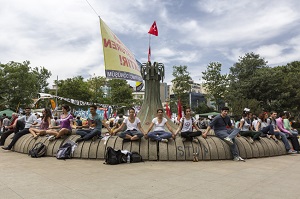Nearly one month after the initial uprising in Istanbul, reports of violent unrest continue as headline news. Saturday demonstrators holding a vigil in honor of the four people killed during the uprising at Taksim Square were once again forced from their positions as police used water cannons, rubber bullets, pepper spray and tear gas to disperse the crowd.
As a recent first-time visitor to Istanbul, just prior to the outbreak of demonstrations, the one persistent concern I had throughout the trip was the lack of green space in the city. Having traversed Istanbul several times over a period of 11 days, by bus, taxi, train and foot, my family and I can only recall five parks. While I am sure there are many more parks in Istanbul than the ones we visited or noted, the overwhelming demand upon these few areas of green space by the exploding population of this city, tied with the chaotic congestion of traffic and noise, is difficult to ignore. The message is clear. More parks are desperately needed in this city.
If you’ve watched the news over the past few weeks, you know the back story. The last week of May, local residents and environmentalists organized a peaceful demonstration at Taksim Square, an area recognized as the progressive, contemporary heart of Istanbul. The protests centered on the pending demolition of a grove of sycamore trees in Taksim’s Gezi Park, one of the few remaining public green spaces within the sprawling city of 20 million. While they slept in tents, police attacked the protestors just before dawn on May 31, using pepper spray, rubber bullets, water cannons and tear gas. Early on in the conflict, Prime Minister Recep Tayyip Erdogan referred to the protestors as “looters” and “troublemakers,” further provoking the situation. Since May 31, protestors in Ankara, Izmir, Antalya, Bodrum and even Konya and Kayseri — where Erdogan has widespread support — have joined 70 other cities in Turkey in what is now being tagged “the Tree Revolution.”

©iStockphoto.com/1001slide
Protests take place in Taksim Gezi Park and globally over possible destruction
of public green space.
Here people are protesting with yoga on Taksim statue at Taksim Square.
Residents and environmentalists in numerous urban communities throughout the world have since staged peaceful demonstrations in defense of urban parkland. Early last week, protests broke out in Beirut, Lebanon, in response to plans for erecting a parking garage under the site of a public park and Jesuit garden. The small park has been a part of the community since the 1600s when the Jesuits first moved in to Lebanon to build schools and sits atop an ancient site that also holds Roman columns and Greek mosaics, as well as several old-growth trees. Environmentalists and residents converged on the site voicing strong opposition regarding the plans. Activists state the 100-foot tall, century-old pines, with their extensive root systems, won’t survive the project.
Will Hutton, columnist for the The Observer in London, recently commented on the disappearance of public land throughout Great Britain, citing the bold Canary Wharf development as an example. London’s Canary Wharf possesses little public space, Hutton writes. Nothing is held in common. It is a "nonplace" whose lack of heart is brutally exposed at weekends and at night when it empties. Privatisation and the values of the transactional, anonymized market have been taken too far. It is a dystopian present foretelling a more dystopian future.
As hundreds of people crowd into city parks throughout Istanbul, defending their right to public parks and green space, people around the world are showing support. It is clear, no matter where you are from, parks and public lands, trees and green space is universally believed to be core to human existence.
What do you think of the reaction of the public in Istanbul and communities everywhere as it relates to their call for protection of public lands? What do you think park and recreation professionals should be doing domestically to ensure people understand the value of public land? Add your thoughts in the comments below.
Gina Mullins-Cohen is NRPA's Vice President of Marketing, Communications and Publications.

